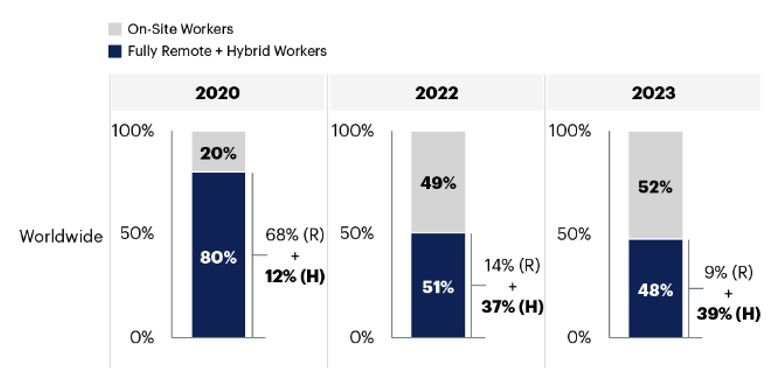- Only 9% of Global Knowledge Workers Will Work Fully Remote.
- Human-Centric Design Can Help Alleviate IT Talent Crunch
By the end of 2023, 39% of global knowledge workers will work hybrid, up from 37% in 2022, according to Gartner, Inc.
“Hybrid is no longer just an employee perk but an employee expectation,” said Ranjit Atwal, Senior Director Analyst at Gartner. “Many employees started to partially return to the office in 2022, but the hybrid workstyle will remain prominent in 2023 and beyond. To adapt, employers have been implementing a human-centric work design – including flexibility, intentional collaboration and empathy-based management – which suits hybrid employees.”
For example, IT workers are more inclined to quit their jobs than employees in other functions as they look for greater flexibility, improved work-life balance and better career opportunities. CIOs can maximize retention and attraction of talent by resetting their employee value proposition with a more human deal.
Gartner defines hybrid workers as workers who work in the office at least one day a week. Fully remote workers are those working from home all the time. On-site workers are those who work on-site full time, not working at home at any time.
The number of remote workers is expected to continue to fall year over year. Gartner estimates that remote workers will represent only 9% of all employees worldwide by the end of 2023 (see Figure 1).
Figure 1: Knowledge Workers’ Share for Fully Remote and Hybrid, Worldwide, 2020, 2022 and 2023

Source: Gartner (March 2023)
While all countries have increased their proportion of hybrid and fully remote work since 2019, the allure of fully remote and hybrid work varies significantly by country.
Human-Centric Design Meets the Virtual Workspace
Human-centric design requires a new set of principles, norms and thinking. Successful virtual workspaces will increase the ability to hire and bring together employees regardless of geographic location. Virtual workspaces provide potentially disruptive new alternatives to in-person meetings (and the associated travel) and to existing, virtual meeting solutions. Gartner predicts that by 2025, 10% of workers will use virtual spaces for activities such as sales, onboarding and working remotely.
“For remote-first or hybrid organizations, fully mature virtual workspaces may replace the office as the embodiment of company culture and become the center of the digital employee experience,” said Christopher Trueman, Senior Principal Analyst at Gartner. “However, employees should not be expected to engage in the virtual workspace for their entire workday. Virtual workspaces should only be used for meetings and interactions that will be enhanced by them, such as brainstorming, product reviews, or social gatherings.”
- มีเพียง 9% ของพนักงานที่จะทำงานจากระยะไกลเต็มรูปแบบ (Work Fully Remote)
- การออกแบบการทำงานที่ยึดมนุษย์เป็นศูนย์กลาง (Human-Centric Design) ช่วยลดปัญหาด้านบุคลากรไอที
การ์ทเนอร์คาดการณ์ว่า ภายในสิ้นปี 2566 จะมีพนักงานที่มีทักษะความรู้ทั่วโลกประมาณ 39% ทำงานแบบไฮบริด (Hybrid) เพิ่มขึ้นจาก 37% ในปี 2565
รันจิต อัตวาล ผู้อำนวยการอาวุโสฝ่ายวิจัยการ์ทเนอร์ กล่าวว่า “การทำงานไฮบริดไม่ใช่แค่การเติมไฟทำงานให้แก่พนักงาน แต่ยังเป็นความคาดหวังของพนักงานอีกด้วย ในปี 2565 มีพนักงานจำนวนมากทยอยกลับไปทำงานที่ออฟฟิศ โดยที่รูปแบบการทำงานไฮบริดจะยังคงได้รับความนิยมอย่างต่อเนื่องในปีนี้และอนาคต บริษัทนายจ้างควรปรับตัวโดยการนำนโยบายการทำงานที่เน้นมนุษย์เป็นศูนย์กลาง (Human-Centric Work Design) มาปรับใช้ในองค์กร รวมถึงเพิ่มความยืดหยุ่นและการมีส่วนร่วมในงาน และมีรูปแบบการจัดการพนักงานที่ทำงานไฮบริดอย่างเข้าอกเข้าใจ”
ตัวอย่างเช่น บุคลากรไอทีมีแนวโน้มลาออกมากกว่าบุคลากรในสายงานอื่น ๆ เนื่องจากพวกเขาต้องการความยืดหยุ่นในการทำงานมากขึ้น และมีสมดุลระหว่างชีวิตและการทำงาน (Work-Life Balance) และมองหาโอกาสในการทำงานที่ดีขึ้น โดยผู้บริหารไอที (หรือ CIOs) สามารถเพิ่มโอกาสในการรักษาและดึงดูดบุคลากรที่มีทักษะความสามารถระดับหัวกะทิได้ โดยการปรับเปลี่ยนแนวคิดใหม่เป็นการมอบคุณค่าแก่พนักงาน (Employee Value Proposition) ที่เข้าใจความเป็นมนุษย์มากขึ้น
การ์ทเนอร์ให้คำจำกัดความ พนักงานกลุ่ม Hybrid Workers คือผู้ที่เข้าทำงานในสำนักงานอย่างน้อยหนึ่งวันต่อสัปดาห์ ส่วนพนักงานกลุ่ม Fully Remote Workers เป็นกลุ่มที่ทำงานที่บ้านตลอดเวลา และพนักงานกลุ่ม On-Site Workers คือพนักงานที่เข้าทำงานในสำนักงานเต็มเวลา
คาดว่าจำนวนพนักงานที่ทำงานผ่านระยะไกล (Remote Workers) จะลดลงทุกปี การ์ทเนอร์ประมาณการณ์ว่าภายในสิ้นปี 2566 จำนวน Remote Workers จะเหลือเพียง 9% ของจำนวนพนักงานทั้งหมดทั่วโลก (ตามภาพที่ 1)
ภาพที่ 1: สัดส่วนพนักงานที่มีทักษะความรู้ทั่วโลกที่ทำงานแบบ Fully Remote และ Hybrid ระหว่างปี 2564 – 2566

ที่มา การ์ทเนอร์ (มีนาคม 2566)
ตั้งแต่ปี 2562 ทุกประเทศมีสัดส่วนการทำงานแบบ Hybrid และ Fully Remote เพิ่มขึ้น โดยมีความแตกต่างกันออกไปอย่างมีนัยสำคัญในแต่ละประเทศ
เมื่อการออกแบบการทำงานที่เน้นมนุษย์เป็นศูนย์กลางมาพบกับพื้นที่ทำงานเสมือนจริง (Virtual Workspaces)
Human-Centric Design หรือการออกแบบการทำงานที่เน้นมนุษย์เป็นศูนย์กลางต้องอาศัยหลักการ บรรทัดฐานและไอเดียใหม่ ๆ ซึ่งพื้นที่ทำงานเสมือนจริง (Virtual Workspaces) ที่ประสบความสำเร็จจะช่วยเพิ่มขีดความสามารถในการสรรหาและว่าจ้างไปจนถึงรวบรวมทีมงานไว้ได้โดยไม่ต้องคำนึงถึงที่ตั้งภูมิศาสตร์ พื้นที่ทำงานเสมือนจริงยังเป็นทางเลือกใหม่ที่ช่วยลดปัญหาในเรื่องการจัดประชุมแบบพบหน้า (รวมถึงการเดินทาง) ด้วยโซลูชั่นการประชุมเสมือนจริงที่มีอยู่ การ์ทเนอร์คาดการณ์ว่าภายในปี 2568 พนักงาน 10% จะใช้พื้นที่เสมือนจริงสำหรับทำกิจกรรมต่าง ๆ อาทิ การขาย การเตรียมพร้อมสำหรับพนักงานใหม่และการทำงานจากระยะไกล
คริสโตเฟอร์ ทรูแมน นักวิเคราะห์อาวุโสของการ์ทเนอร์ กล่าวว่า “สำหรับองค์กรที่ทำงานแบบไฮบริดหรือทำงานจากระยะไกลนั้นพื้นที่สำนักงานจริงอาจถูกแทนที่ด้วยพื้นที่ทำงานเสมือนจริงอย่างเต็มศักยภาพ จนกลายเป็นศูนย์รวมของวัฒนธรรมองค์กร และเป็นศูนย์กลางการทำงานที่สร้างประสบการณ์ดิจิทัลให้พนักงาน อย่างไรก็ตามพนักงานไม่ควรคาดหวังว่าจะมีส่วนร่วมในพื้นที่ทำงานเสมือนจริงตลอดทั้งวัน แต่ควรใช้พื้นที่นี้สำหรับการประชุมและการสร้างปฏิสัมพันธ์เพื่อพัฒนาศักยภาพให้กับตนเอง อาทิ การระดมไอเดียต่าง ๆ (Brainstorming) การทดสอบผลิตภัณฑ์ (Product Reviews) หรือ การพบปะทางสังคม (Social Gatherings)”

